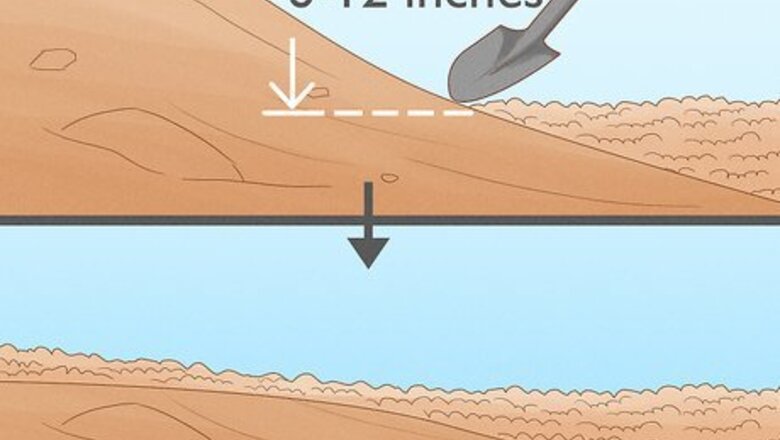
views
Building a Terrace
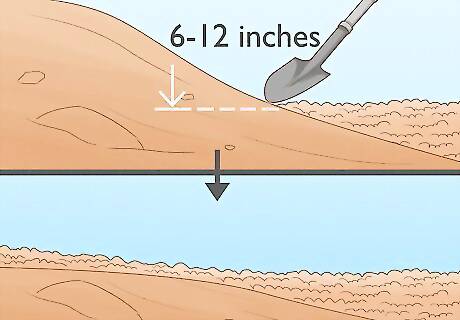
Dig approximately 6 to 12 inches into the slope to level off an area. The exact depth will depend upon the root length of the plant you have chosen. The roots need to be full covered with an additional inch or two of soil. Having a leveled off area will make it easier for the plants you choose to successfully root in the soil. It is easier for plants to grow up from a flat surface than attempt to grow on an angled surface. Creating a terrace will also make it easier for you while planting. The terrace will ensure your landscaping remains strong on the slope. In order to create a terrace, dig out about 6 inches of the earth to make a flatter space for planting. The depth might be deeper depending upon the type of plant or tree you are planting. It’s important not to dig out too much earth at once because it will make the ground more unstable.
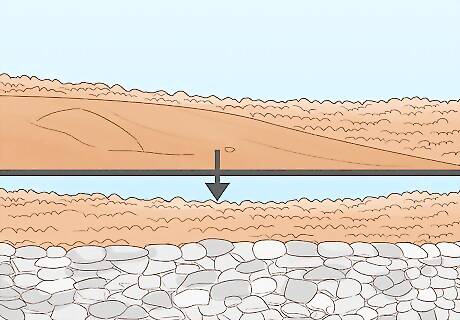
Create a retaining wall with ground soil or rock. You can also choose to leave the original slope undisturbed and instead build a retaining wall. There are two main options to build a retaining wall. You can either use rocks or extra top soil to build up the ground. Either way, a retaining wall will offer a very secure way to prevent your plants from moving down the slope and will also aid in moisture retention. Use extra top soil from 6 inches to one foot to build a retaining wall. This will prevent plants from moving down the slope. Another option is to create a wall made from rock to keep plants from sliding down the slope. You will want your rock height to be around 6 inches to 1 foot off the ground. If you add rock you will need to dig in at least 1/3 the length of the rock to place it in the ground. This will ensure the rocks do not slide down the slope. Many people choose to use rocks with a rugged look to keep with the natural terrain.

Alternate berms and swales down the slope. Berms are built up areas while swales are depressions in the soil. When planting dig in approximately 6 inches to one foot into the soil to plant. Then, build up the soil in a half moon shape below whatever foliage you have planted. This will help each individual plant get enough water and will also ensure that the plants roots are able to thrive. This combination technique is very helpful to provide a stable environment for your planting.
Planting Your Foliage
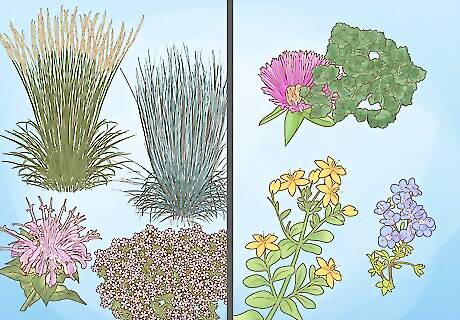
Pick plants with clumping roots. When deciding what kind of plants, you want to pick, the root type is the most important thing to consider. When it comes to planting on a hillside or any kind of sloping terrain, plants with clumping roots are ideal. Clumping root plants are the best kind of foliage for a slope because of how secure the roots will make the plants in the ground. Plants that have clumping roots include trees, shrubs and grasses. Some options include: Indiangrass, Little Bluestem, Wild Bergamot and Creeping Flox. You can also use ground cover to fill spaces in between other plants. Some popular groundcover plants include: St. John’s Wort, Creeping Raspberry, Purple Ice Plant and Georgia Blues Veronica.
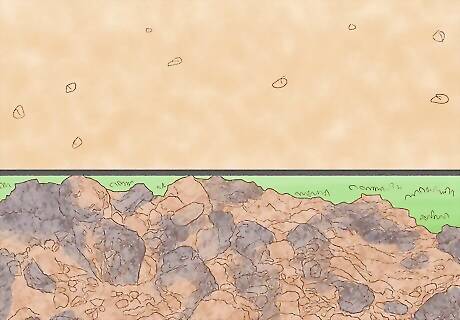
Analyze the soil to determine the type. It’s necessary to determine your slope to know which plants are best to plant. Your soil can range from a variety in types including sandy or clay-based. Different kinds of soil will do better with different types of plants. Other things to keep in mind are sun and climate. If your slope gets a lot of sun, you will need to plant accordingly. EXPERT TIP Steve Masley Steve Masley Home & Garden Specialist Steve Masley has been designing and maintaining organic vegetable gardens in the San Francisco Bay Area for over 30 years. He is an Organic Gardening Consultant and Founder of Grow-It-Organically, a website that teaches clients and students the ins and outs of organic vegetable gardening. In 2007 and 2008, Steve taught the Local Sustainable Agriculture Field Practicum at Stanford University. Steve Masley Steve Masley Home & Garden Specialist Add organic matter to your soil to make it healthier. Steve Masley and Pat Browne, owners of Grow it Organically, say: "The main things is, you always need organic matter. If you have heavy clay soil, you need to add something like perlite, coarse lava rock, or course builder sand, along with a lot of compost. That increases the porosity of the soil and helps it drain better. If you have sandy soil, a lot of the bacteria and things flush down because they don't have any place to sit. If you add biochar and other organic matter, those bacteria have a surface to grow on."
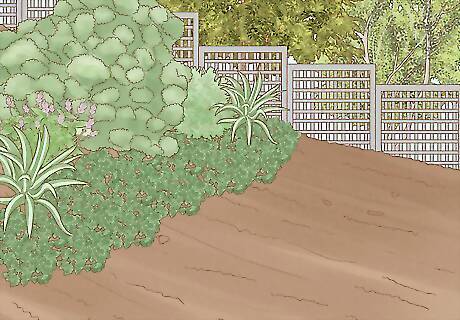
Plant drought resistant plants at the top of the slope. You should pick the right spot for each individual plant. Choose where to place your plants strategically as water will run downhill. Some plants need more water than others so it is best to plant those that need less water at the top of your slope and those that need more at the bottom. Strategically planting, including with certain types of plants in different spaces on your slope, will help you devote less time to maintenance.
Caring for the Plants
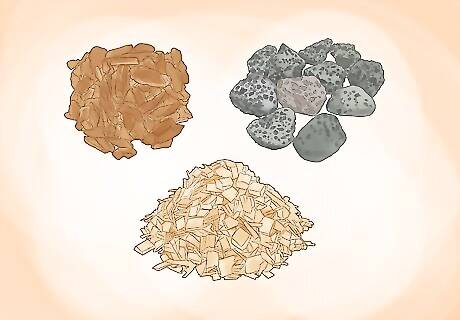
Use mulch to enrich and provide extra support for the soil. Adding mulch will both keep your soil healthy, prevent it from spreading and also aid in moisture retention. Some of the best options mulch on a slope include lava stone (pumice rock), rock mulch or wood chips and shredded bark. Mulch can also be aesthetically pleasing and add a more uniform look to your landscaping. Before choosing mulch, look at your natural terrain. Because moisture retention is usually an issue, you will want to choose mulch that will help keep water in. You might choose to match your mulch to your natural terrain. For instance, if you have chosen to plant a lot of trees or live in a more forested area, you might choose to use the wood chips or shredded bark option.
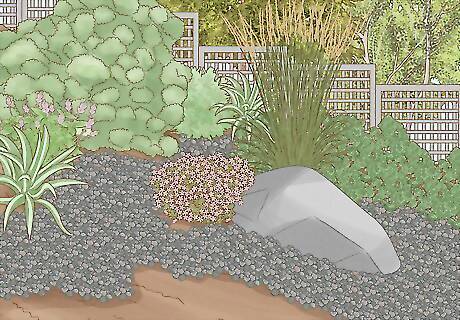
Place mulch at the base of each plant and in between any rocks. If you have not used any rocks to landscape, mulch is still a valid option to use on your slope. Much will prevent soil from sliding down the slope. It will also help to anchor whatever you have planted while keeping the soil healthy. If soil slippage is an issue, you might choose the rock mulch option. The weight of the rocks will help to weigh down the soil.

Calculate the amount of mulch you need. The amount of mulch you need will vary depending upon the kind you use. The heavier the mulch the less of it you will need. Ideally you will want to mulch 4 inches up from the base of your plant. Keep in mind, if you use organic mulch, you will need to replace it every year or so as it will break down and absorb into the earth.
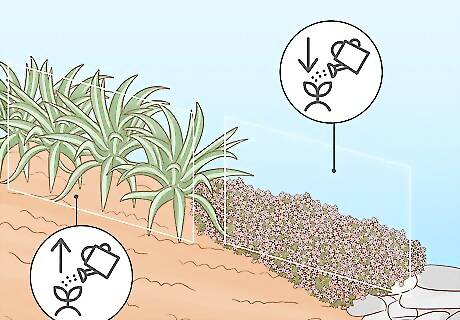
Inspect the foliage to ensure it stays healthy and hydrated. Because water will flow down the slope you will need to be sure that whatever you have planted at the top is getting enough water. Your plants at the bottom of the slope will likely get plenty of water. Some people have chosen to irrigate their slope to keep their plants thriving. You can also choose plants that don’t need much water, especially at the top of the slope.
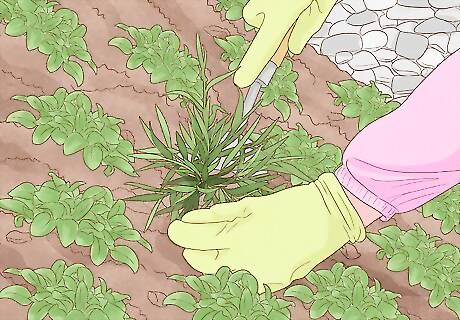
Remove weeds carefully to keep the surrounding soil undisturbed. If you simply rip the weeds out of the ground, you could cause the ground soil to become loose and unstable on the slope. It’s better to pull out weeds as you seem them sprout, when they are small and unlikely to cause damage to the soil around them. If you plant groundcover plants, they will eventually prevent weeds from growing. You can also use mulch to smother weeds. Mulch is also helpful to keep soil healthy.




















Comments
0 comment